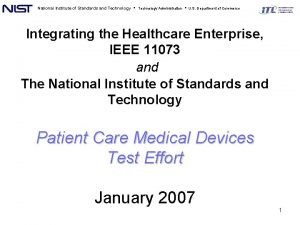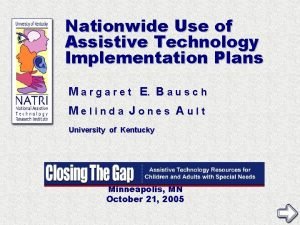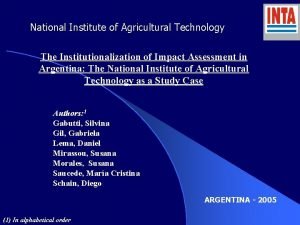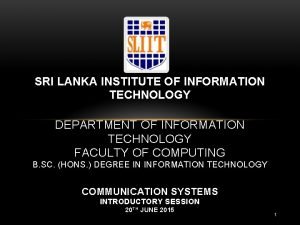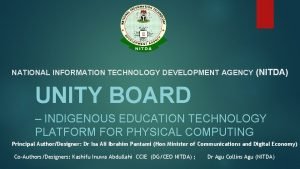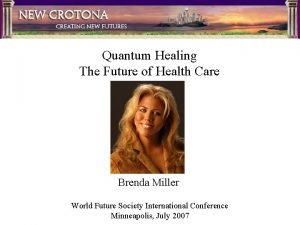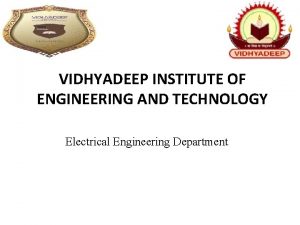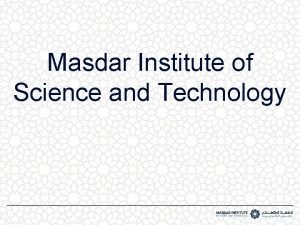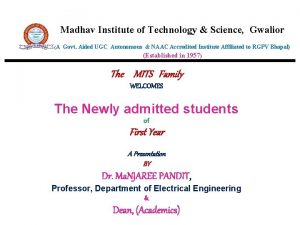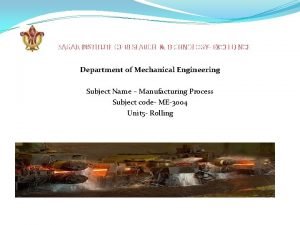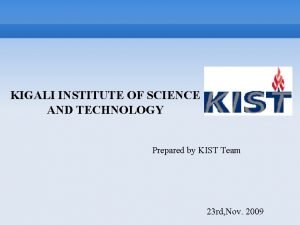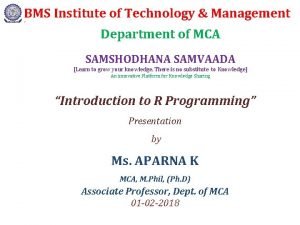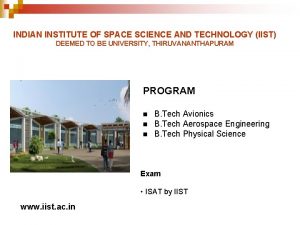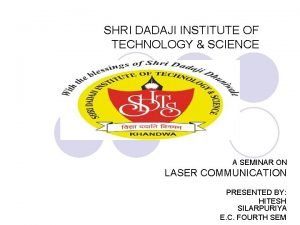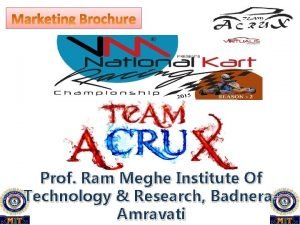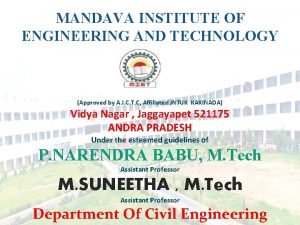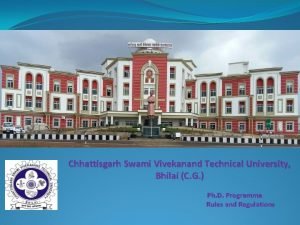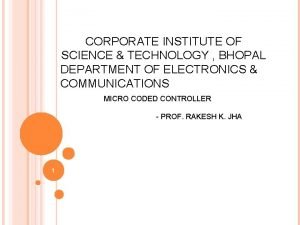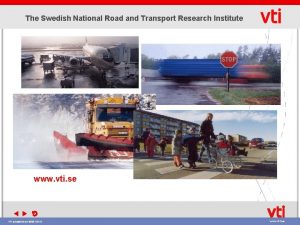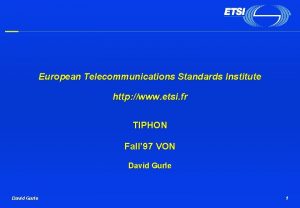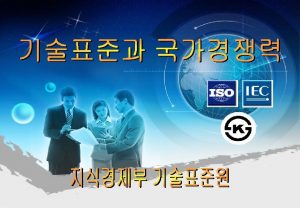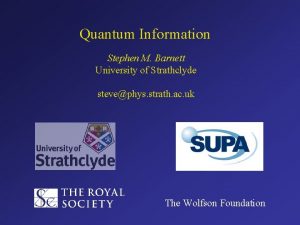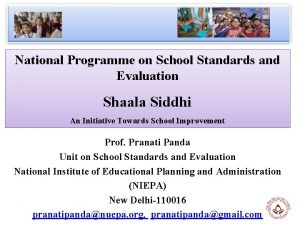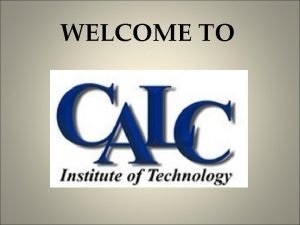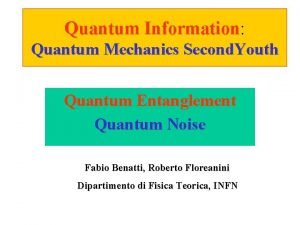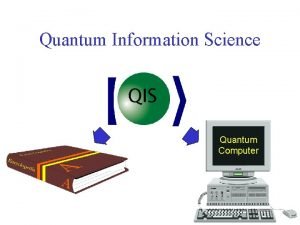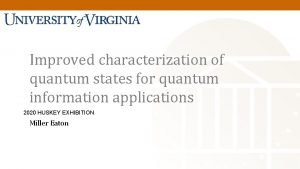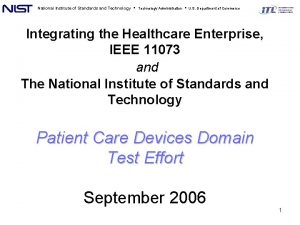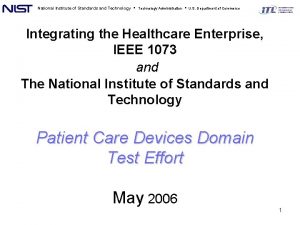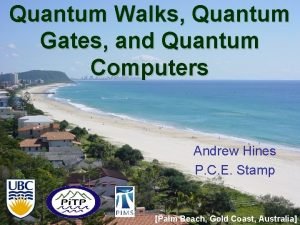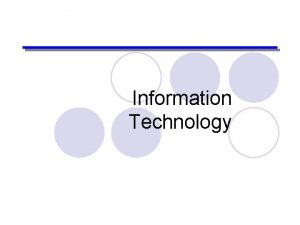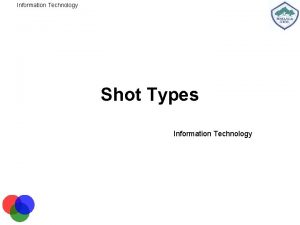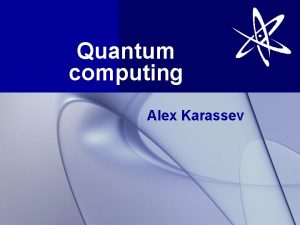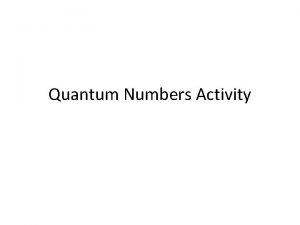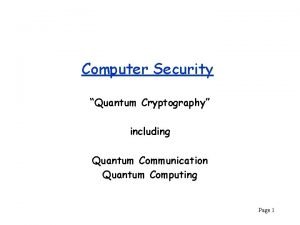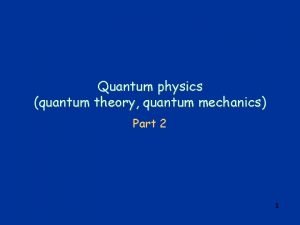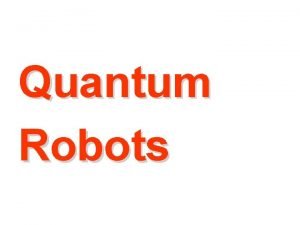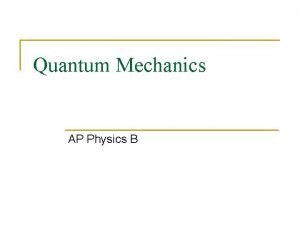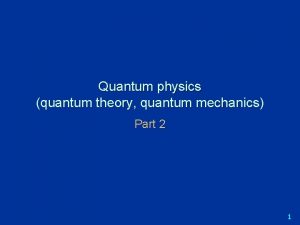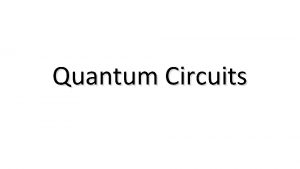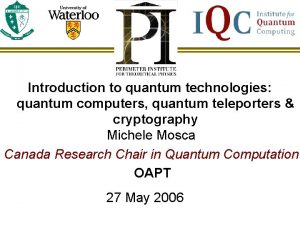National Institute of Standards and Technology Quantum Information































- Slides: 31

National Institute of Standards and Technology Quantum Information Program “Quantum Computing with Atoms in Optical Nanostructures” William D. Phillips Laser cooling and trapping group National Institute of Standards and Technology Gaithersburg MD 20899 -8424 william. phillips@nist. gov NNI Interagency Workshop Instrumentation and Metrology for Nanotechnology Grand Challenge Workshop 27 -29 January 2004 Gaithersburg MD Sponsors: 1 1

Two Questions: What is quantum computing? What does it have to do with Nanotechnology? 2

Two Questions: What is quantum computing? A: An entirely new paradigm for information processing, with astounding potential for improved speed of calculation. What does it have to do with Nanotechnology? A: Almost everything 3

A quantum computer would be more different from today’s digital computers than today’s computers are from the abacus. 4

Today, a wide variety of government agencies, industrial and commercial concerns are heavily invested in the study of quantum information. Why all the interest? • Quantum computers, if made, could solve problems that are impossible to solve with ordinary, classical computers. • Quantum processing allows measurements to be made at the limits set by quantum mechanics--huge potential improvements. • Quantum communication offers security against eavesdropping, guaranteed by the laws of physics. 5

The “Killer App. ” Factoring numbers is a difficult problem--the time required grows exponentially with the digits in the number to be factored. The difficulty (impossibility) of factoring large numbers (and the ease of creating a large number from its factors) is the basis of public key encryption (which nearly everyone uses for secure transmission today). A quantum computer would be able to use Shor’s Algorithm to factor numbers in a time growing only as a power of the number of digits. 6

Quantum information has captured the imagination of people ranging from physicists to science fiction writers! “Using Shor’s quantum factorization algorithm, one can see that factoring a large number can be done by a QC – quantum computer – in a very small fraction of the time the same number would take using ordinary hardware. A problem that a Super. Cray might labor over for a few million years can be done in seconds by my QC. So for a practical matter like code breaking, the QC is vastly superior. ” … “Wineland Monroe worked out the single quantum gate by trapping beryllium ions. …” ----Clancy and Piecznik N. B: Wineland Monroe, at NIST-Boulder 7

But Quantum Information/Computation is NOT science fiction and there is lots of active research at NIST, throughout the US and around the world. Why? • There are lots of important applications. • The issues of quantum information go to the heart of the most mysterious and fundamental aspects of physics. • The known computation power for interesting problems is astounding: factoring and other Shor-algorithm-like problems have a different complexity class! • Quantum computers might be able to solve GENERAL hard problems. The implications are mind boggling!! 8

Implications of general solutions of “hard” problems “Setting aside the constraints of any particular computational model, the creation of a physical device capable of brutally solving NP problems would have the broadest consequences. Among its minor applications it would supercede intelligent, even artificially intelligent, proof finding with an omniscience not possessing or needing understanding. Whether such a device is possible or even in principle consistent with physical law, is a great problem for the next century. ” Michael H. Freedman (Fields Medalist) Microsoft Corporation Source: “Topological Views on Computations Complexity, ” Documenta Mathematica, Extra Volume ICM 1998, II, 453 -464 9

Classical Bits vs Quantum Bits Classical Bit: 0 or 1; or Quantum Bit (Qubit): Can be a quantum superposition of 0 and 1 y = + qubit Superposition is one of the two weirdest things about Quantum Mechanics; Entanglement is the other. It is what gives quantum computing its power! 10

The Einstein-Poldoski-Rosen “Paradox” Before you measure, the spins could have either direction. ? ? | >|> - |>|> When you measure, the spins they are always anticorrelated--entangled, in a way impossible if the spins’ values existed before measurement-a weirdness that spooked Einstein 20 th Century quantum technology doesn’t generally use the weirdness of quantum mechanics. Quantum information technology DOES--a second quantum revolution!! 11

Scaling is the key to the power of Qu. Information. • Classically, information is stored in a bit register: a 3 -bit 1 0 1 register can store one number, from 0 – 7. • Quantum Mechanically, a register of 3 entangled qubits can store all of these numbers in superposition: a|000 + b|001 + c|010 + d|011 + e|100 + f|101 + g|110 + h|111 Result: -- Classical: one N-bit number -- Quantum: 2 N (all possible) N-bit numbers • N. B. : A 300 -qubit register can simultaneously store more combinations than there are particles in the universe. • Problems in both cryptography and physics benefit from this exponential scaling, enabling solutions of otherwise 12 insoluble problems.

Another “Killer App. ” We live in a quantum world, but we try to model its behavior with classical computers. Classical computers are inadequate, because the size of the problem grows exponentially with the size of the physical system. Quantum computers work the problem as nature would. Richard Feynman’s recognition of this fact started modern interest in quantum information. 13

A Killer Metrology Application (e. g. , spin-squeezing in Wineland’s group) The nature of uncertainty is of primary concern in accurate measurement uncertainty N classical, independent atoms shot-noise limit N quantum-entangled atoms Heisenberg limit 14

One more killer app. -- Quantum Communication Quantum Repeater Alice ? 1 Eve can only obtain information by destroying the qubits (no-cloning theorem) Bob Eve 15

A New Science! Quantum Mechanics 20 th Century Information Science The second quantum technology revolution Quantum Information Science 21 st Century 16

Real Qubits What is a qubit, physically? It must be, in some sense, small enough to be quantum mechanical (which is why QI is usually nanoscale) Some examples: § Photons (N. B. NIST QKD testbed) § Quantum Dots § Single Cooper-Pair Boxes § Josephson-Junction Circuits (N. B. Martinis’s program) § Nuclear spins in liquids § Electron/nuclear spins in solids § Single Isolated Ions (N. B. Wineland’s program) § Single Isolated Atoms 17

(Simplified) Atomic Qubit An atom with nuclear and electron spins higher energy state: 1 lower energy state: 0 An atom can be 1 , or it can be 0 , but it can also be 1 + 0 2 18

Atom-Light Interaction & Traps Optical lattice holds, manipulates atoms by light shift Light shift e g Counter-propagating laser beams D hn create a standing wave. Periodic light-shift potential = optical lattice Photon scattering (decoherence) ~ W 2/D 2 so decoherence can be made small 19

The periodic potential of an optical lattice is a natural, nanoscale register for atomic qubits w w ~400 nm 20

Loading a BEC into a Lattice Bose-Einstein Condensate: Huge number of atoms in lowest state in a magnetic trap Bose-Einstein Condensation + Optical Lattice Adiabatic turn-on: All of the BEC in the lowest state. Non-adiabatic: superposition of excited states. 21

Measuring the loading of a lattice Suddenly (non-adiabatically) releasing the atoms from the lattice projects the lattice wavefunction into free space. The periodic wavefunction has momentum components at multiples of the reciprocal lattice momentum-- twice the photon momentum (2 nhk). (This is the same as diffraction!) 22

Temporal Evolution of Loaded, 1 -D Lattice Adiabatic time Non-adiabatic Adiabatic loading puts atoms > 99. 5% in the ground state. 23

But, we also need to have just one atom per site! Mott transition: initialization of >105 qubits in a 3 -d lattice Mott Lattice is deepened adiabatically; repulsive interactions arrange atoms, one per site. Phil. Trans. R. Soc. Lond. A 361, 1417 (2003) Lattice Depth BEC 200 ms (similar results in Munich) According to theory, ground state provides a very high fidelity initialization of a massive register of neutral atom qubits (at V 0= 35 ER, < 5% chance of any of 105 sites having an error). 24

Quantum Processing: single bit operations (excited state) w 1 Raman transitions: two laser beams induce transitions between the atomic qubit states. w 2 25

A problem: atoms in adjacent lattice sites are not optically resolved tightly focused laser beam hits more than one atom We want tightly confined atoms, far enough apart to resolve with a laser. 26

Our approach: Use a superlattice to localize atoms into every nth lattice site 27

Patterned loading x p NIST-Gaithersburg 2002 28

Quantum Processing: 2 -bit gate operations 2 -bit, neutral-atom universal gates work by entangling atomic states through coherent atom-atom collisions. A simple approach is the Cirac. Zoller gate in which stateselective movement of atoms and ground-state, on-site interaction between atoms accomplishes the entanglement: atom 1 atom 2 Preliminary results on controlled coherent phase shift in Munich move s+ s 29

Where we stand in quantum computation with neutral atoms in optical nanostructures: • The needed tools (qubits, gates, readout, …) have all been demonstrated in principle. • We need to do operations at the single atom level (nanoscale manipulation and detection). • We need high fidelity of operations--nanoscale metrology 30

Conclusions When will we have a quantum computer? A small-scale processor (~ 10 qubits), capable of acting as a quantum repeater, should be available within the decade. A larger scale computer that can factor large numbers will be very difficult, but no fundamental roadblocks have appeared. It will probably take more than 20 years. Quantum information/engineering is a already a reality: Prototype quantum communication systems are operating in several locations (including NIST). Processors that can simulate important condensed matter problems at the nanoscale are on the horizon. 31
 National institute of standards and technology
National institute of standards and technology Unist application fee
Unist application fee Assistive technology implementation plan
Assistive technology implementation plan National institute of agricultural technology
National institute of agricultural technology Courseweb.sliit.lk
Courseweb.sliit.lk Sri lanka institute of information technology affiliations
Sri lanka institute of information technology affiliations Quantum physics vs quantum mechanics
Quantum physics vs quantum mechanics Quantum physics vs quantum mechanics
Quantum physics vs quantum mechanics National information technology development agency
National information technology development agency Quantum edge healing institute
Quantum edge healing institute Vidhyadeep institute of engineering and technology
Vidhyadeep institute of engineering and technology Masdar institute of science and technology
Masdar institute of science and technology Madhav institute of technology and science
Madhav institute of technology and science Vocational education uae
Vocational education uae Sagar institute of research and technology
Sagar institute of research and technology Kigali institute of science and technology
Kigali institute of science and technology Download r for windows
Download r for windows Iist pune
Iist pune Shri dadaji institute of technology and science
Shri dadaji institute of technology and science Prof ram meghe institute of technology and research
Prof ram meghe institute of technology and research Mandava institute of engineering and technology
Mandava institute of engineering and technology Swami vivekanand institute of technology and management
Swami vivekanand institute of technology and management Corporate institute of science and technology bhopal
Corporate institute of science and technology bhopal Customer defined service standards
Customer defined service standards Regulatory agencies
Regulatory agencies Swedish national road and transport research institute
Swedish national road and transport research institute European telecommunications standards institute
European telecommunications standards institute Korean agency for technology and standards
Korean agency for technology and standards Quantum information stephen barnett solutions
Quantum information stephen barnett solutions Shaala siddhi school evaluation dashboard
Shaala siddhi school evaluation dashboard Calc institute of technology
Calc institute of technology Waterford institute of technology vacancies
Waterford institute of technology vacancies
